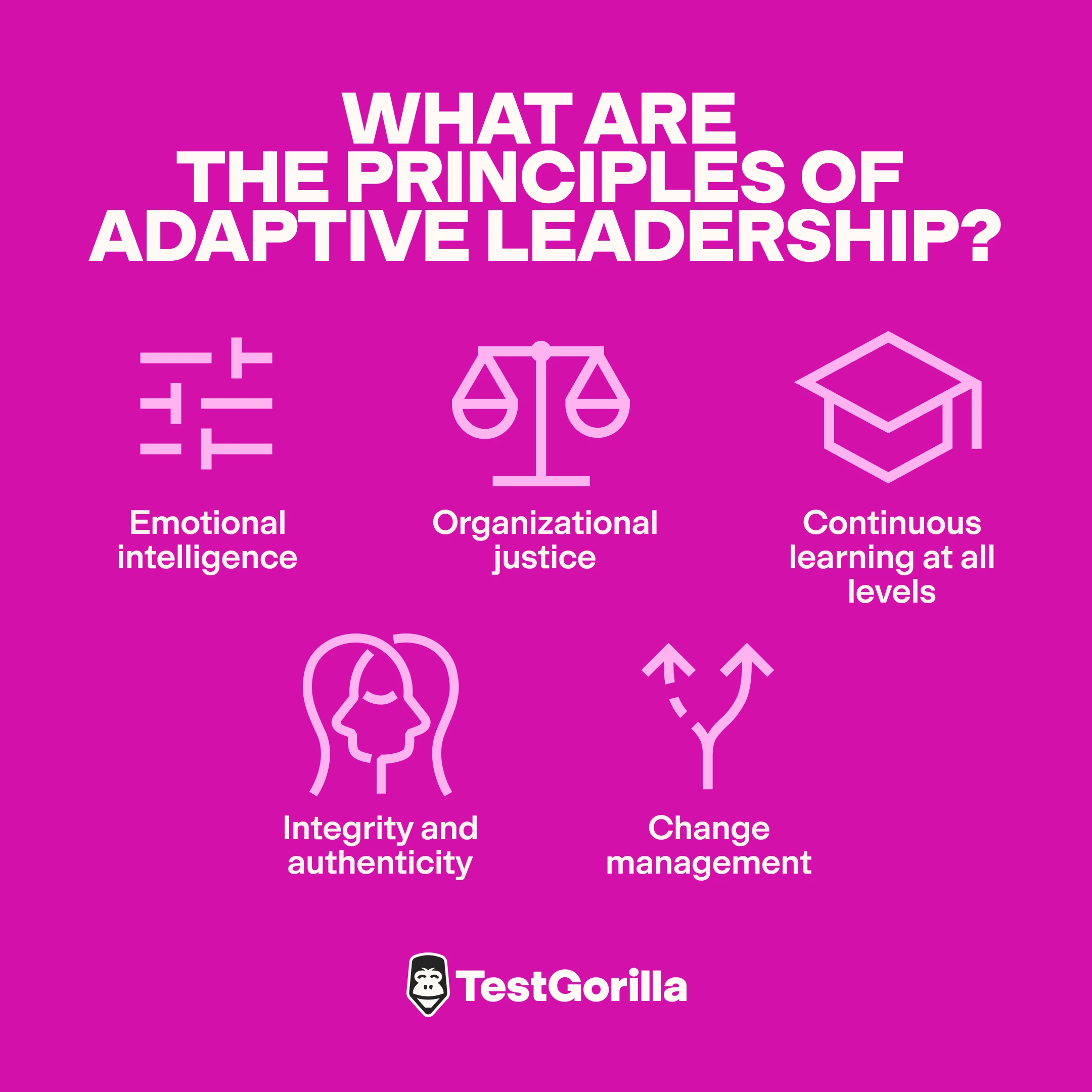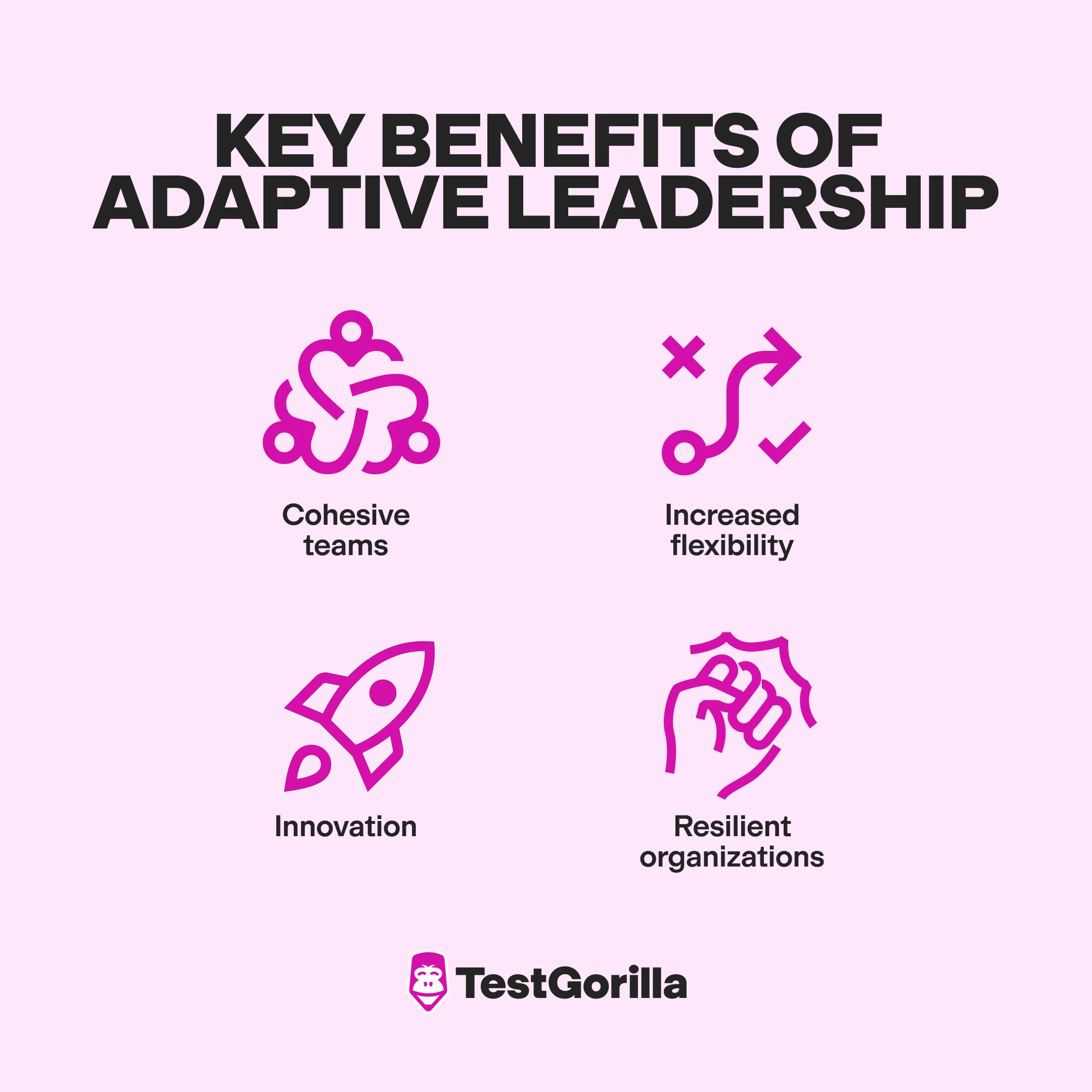What is adaptive leadership?
Adaptive leadership is a leadership style that focuses on a leader’s ability to be flexible, learn continuously, and navigate ever-changing business environments. It's as applicable to small startups as it is to huge corporations – and it spans industries.
Harvard professor and leadership expert Ronald Heifetz introduced the concept to address complex, ongoing business challenges and change. Heifetz said leaders must find ways to make change work.
The adaptive leadership model is especially effective for leading through challenges that require a shift in mindset, culture, or behavior.
Table of contents
What are the principles of adaptive leadership?
Emotional intelligence means managing your own emotions and those of others. This principle is about fostering trust, boosting morale, and creating work environments where employees feel heard and motivated to achieve company goals.
Organizational justice: This principle is about actively seeking input from all levels of the organization, making sure employees feel heard, and creating cultures of equality and justice.
Development: Recognizing that continuous learning at all levels helps drive organizational growth, this principle is about embracing failure as part of the path to success, encouraging employees to realize their full potential, and promoting a culture of innovation.
Character: Integrity and authenticity are central to adaptive leadership. This principle is about earning teams’ respect and instilling the confidence teams need to rally behind company goals.
Change management: Change is inevitable. This principle is about adjusting strategies as the business environment evolves.
How to identify an adaptive leader
Identifying an adaptive leader requires looking for personal traits that line up with the principles outlined above.
Key traits of successful adaptive leader are:
Adaptable: Are flexible in their approach and able to meet new challenges and changing environments
Goal-oriented: Take deliberate action with a clear outcome in mind
Visionary: Have their eye on the future and inspire others to work toward organizational goals
Committed: Understand that large-scale change doesn’t happen overnight – and remain invested in achieving long-term goals
Proactive: Identify challenges and take action before they arise
Open-minded: Are open to diverse perspectives and ideas, encouraging innovation and collaborative problem-solving
Honest: Embody truthfulness and fairness – and are transparent in their communication style
Learn more about which other skills to look for when hiring adaptive leaders by checking out our guide on adaptability skills.
What are the benefits of adaptive leadership?
Here are the key benefits of adaptive leadership.
1. Cohesive teams
Adaptive leaders build trust among their employees, and help them stay aligned and committed to achieving organizational goals. The result? Stronger, lined-up teams.
While lined-up teams are important in periods of stability, they’re vital when navigating tricky challenges and uncertainty.
2. Increased flexibility
Because adaptive leaders anticipate challenges, adjust to evolving circumstances, refine strategies based on new info, and promote innovation, their companies are well-equipped to navigate whatever the future holds.
3. Innovation
Openness to multiple viewpoints can result in more innovative solutions. And individual team members who feel their opinions are valued are also more likely to engage in collaborative problem-solving.
In 2015, Adobe launched its Kickbox Innovation program to empower employees to develop their own ideas and drive business impact. Since then, Adobe made the method open-source, and thousands of organizations – including multinationals, educational institutions, and government agencies – have adopted it.
Adobe’s VP of Creativity, Mark Randall, said that the program’s focus is on “creating more innovators” and that “investing in our people… will pay dividends for years.”
4. Resilient organizations
Since adaptive leaders lay the foundations for their organizations to survive – or even thrive – during uncertain times, they foster resilience within their teams. The result? When problems arise, the company adapts and takes decisive action rather than merely reacting.
The best insights on HR and recruitment, delivered to your inbox.
Biweekly updates. No spam. Unsubscribe any time.
Steps to hiring an adaptive leader
An applicants' industry experience won’t tell you if they have the traits of an adaptive leader.
So, you must follow these steps to identify candidates with the right traits.
1. Write an adaptive leader job description
A well-thought-out job description sets the stage for a successful hiring process. Attract high-quality candidates by clearly outlining the responsibilities and the skills candidates must bring to the table.
Incorporate the key traits of successful adaptive leaders to drum in the importance of these qualities. Highlight adaptive actions – like adjusting strategies in response to new data or changing circumstances – to lure in applicants with the essential skills.
Finish with the compensation and benefits of working for your company.
2. Use objective assessments
Data-driven assessments can give you an objective overview of all your leader applicants. These scientifically-backed assessments look below the surface and deliver valuable insights into each applicant's leadership capabilities and suitability for the role.
Here are some examples:
Role-specific tests: These test role-specific leadership skills, such as people management skills and remote team management abilities.
Cognitive ability tests: These look at problem-solving, critical thinking, and other vital cognitive abilities.
Personality tests: These evaluate candidates' personal traits and emotional intelligence.
Communication tests: These assess candidates' ability to communicate using verbal, written, and non-verbal communication.
We always recommend taking a multi-measure approach to hiring, but when you're hiring a leader, you can't afford not to. Leaders wear many hats and shoulder complex responsibilities. Combine tests to evaluate candidates on various leadership “measures” – skills and traits – that are crucial to your role and organization.
3. Interview shortlisted candidates
Once you’ve narrowed down your applicant pool using assessments, interview your shortlisted candidates.
Asking the right leadership interview questions is crucial to assess their suitability for the role.
Behavioral questions – which explore past behaviors – and situational questions – which focus on hypotheticals – are great for understanding how candidates will lead, drive productivity, cope with the unexpected, and line up with your organization and its long-term goals. Here are some examples:
Describe a time when you successfully led a team through an unexpected challenge.
How would you handle a situation where a team is falling behind on a key project?
Explore TestGorilla's blog to learn more about identifying and hiring the best candidates for leadership roles.
FAQs
Who are famous adaptive leaders?
Abraham Lincoln is often cited as an adaptive leader. Nicknamed "Honest Abe," he championed inclusivity and welcomed diverse perspectives. Sheryl Sandberg, the former COO of Meta Platforms, is also known for her adaptive leadership style.
What is the opposite of adaptive leadership?
Authoritarian leadership is a close opposite to adaptive leadership. Authoritarian leaders tend to maintain strict control over their teams and make decisions without seeking their input. This limits companies’ ability to respond to new challenges, as all decisions must come from one leader. Consequently, adapting to change is tougher… and slower.
You've scrolled this far
Why not try TestGorilla for free, and see what happens when you put skills first.
















